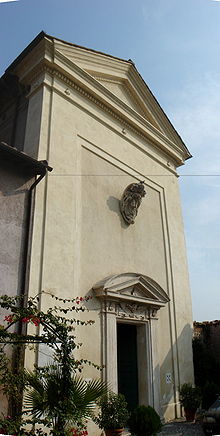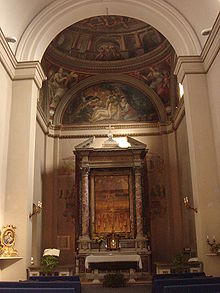San Sebastiano al Palatino
| Basic data | |
|---|---|
| Patronage : |
St. Sebastian |
| Consecration day : | |
| Cardinal Deacon : | Edwin Frederick O'Brien |
| Address: | Via di San Bonaventura, 1 00186 Roma |
San Sebastiano al Palatino , also San Sebastiano alla Polveria , officially San Sebastiano e Zotico is a small church in Rome . It is the title diakonia of the Roman Catholic Church and was the scene of a conclave .
location
The church is located in the X. Roman Rione Campitelli in the immediate vicinity of the Roman Forum , about 250 meters southwest of the Colosseum .
History and building history
The original name of the church, Santa Maria in Pallaria refers to the Palladium , so to the legend of Aeneas in Troy stolen and brought to Rome Minerva image , which in the 3rd century from the Temple of Vesta in the temple of Elagabalus have been brought should. This temple was built by Emperor Elagabal on a large terrace on the Clivus Palatinus, which dates back to Republican times. The St. Sebastian is intended, according to tradition on the Gradus Helagabali (stages of Elagabalus) his martyrdom suffered. Therefore the church was built over parts of the temple. Parts of the complex were excavated in the vicinity of the church.
The first church building at this point dates from the 10th century, possibly even earlier.
The small church became a conclave on January 24, 1118 on the occasion of the election of Pope Gelasius II. The election was canonical, but was carried out in secret because Emperor Henry V was feared to interfere . Immediately after the election, Cencius Frangipani , a party member of the emperor, broke the door, abused the newly elected Pope and had him chained until the following day.
Pope Urban VIII had the now dilapidated church rebuilt in the Baroque style from 1624 . He commissioned an artist to make the altarpiece Martyrdom of St. Sebastian with eight figures , leaving the choice of the figures to the artist. The architect of the almost entirely baroque new building was Luigi Arrigucci .
It got its second nickname from a powder depot of the French troops that was located nearby during the Napoleonic period.
building
The facade, like the rest of the church from the outside, is almost completely unadorned. An equally simple triangular gable rises above the portal's simple triangular gable , which is traversed by a round arch and underlaid with a putti . The facade is framed and bears representations of the heraldic animal of the Barberini family , the bee, in the portal, in the architrave as well as in the pilasters of the portal . Pope Urban VIII came from this family, his coat of arms is attached to the facade.
The inside is just as sober. The very small interior is spanned by a barrel vault, the tiny dome above the choir can only be seen inside and cannot be seen from the outside.
The frescoes behind the altar come from the previous building of the 10th century, those on the dome from the renovations of the Baroque.
The church still contains two memorial plaques, one commemorates the events of Gelasius II, the other the renovation by Urban VIII.
Cardinal deacons
- Ferdinando Giuseppe Antonelli pro illa vice (1973–1993)
- Yves Congar (1994–1995)
- Dino Monduzzi (1998-2006)
- John Patrick Foley (2007-2011)
- Edwin Frederick O'Brien (since 2012)
Cardinal O'Brien took possession of the Church on October 25, 2012.
literature
- Filippo Coarelli : Rome - An Archaeological Guide . Revised by Ada Gabucci. Zabern, Mainz 2000, ISBN 3-8053-2685-8 , pp. 178-180.
- Hans Kühner: Lexicon of the Popes from Peter to Paul VI. Claasen Verlag, Stuttgart and Zurich (no year).
- Herbert Rosendorfer : Church leader Rome. 3rd, updated edition. Edition Leipzig, Leipzig 2005, ISBN 3-361-00485-3 .
- Rolf Tomann (Red.): The art of the baroque: architecture, sculpture, painting . Könemann, Cologne 1997, ISBN 3-89508-991-5 .
- Johann M. Wiesel: Rome. An art and travel guide . 4th edition, Kohlhammer, Stuttgart 1966.
Web links
Individual evidence
- ↑ Coarelli, Rome - An Archaeological Guide , pp. 178–180.
- ^ A b Rosendorfer: Kirchenführer Rom , p. 239.
- ↑ a b Kühner: Lexicon of the Popes , p. 90.
- ↑ Tomann (Red.): Die Kunst des Barock , p. 374.
- ↑ Wiesel: Rome. An art and travel guide , p. 49.
- ↑ Vatican Information Service, 09-10-2012 - Year XXII - Num 181st
Coordinates: 41 ° 53 '22.9 " N , 12 ° 29'19.1" E

